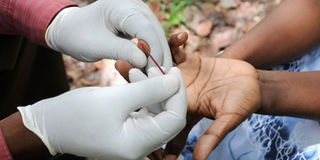Why HIV+ women get late cervical cancer

For all cancers, early diagnosis and treatment is one of the most important factors for recovery. File photo
Cervical cancer is the leading cause of death for HIV positive women in Uganda. This is because they report with the cancer at a very late stage according to Uganda Cancer Institute (UCI).
A research study done by Dr Noleb Mugisha, an oncologist specialising in cervical cancer at UCI shows that despite being on ARVs and regular care in the HIV clinics where practitioners understand the risk of cervical cancer, HIV positive women usually present with the cancer at a late stage.
Dr Mugisha says most of the women who were contacted during the research study had been on HIV treatment for about six years and the stage of the cancer when they first appeared for diagnosis was late.
Statistics
The World Health Organisation estimates that in 2014, approximately 3,915 Ugandan women were diagnosed with cervical cancer and 2,160 died from the disease.
The prevalence of cervical cancer in Uganda is at 34 per cent.
This, coupled with low screening uptake has resulted in the country having one of the highest cervical cancer incidence rates in the world of 47.5 per 100,000 per year.
Infections including those from HIV/Aids and Hepatitis contribute about 50 per cent of cancer deaths with 300,000 new cases annually according to the Kampala cancer registry.
Furthermore, at the Uganda Cancer Institute, 80 per cent of the women who present with cervical cancer have advanced stage disease. Given the high prevalence of genital Human Papilloma Virus infection, the absence of a national cervical cancer prevention and control programme, the cases and deaths are more likely to increase.
Why present late?
Uganda, like most developing countries, lacks the infrastructure and trained personnel needed for the screening. Screening for cervical cancer should be done every three years for HIV-negative women and annually for HIV-positive women.
Dr Mugisha, however, says screening HIV positive women is one of the missed opportunities they have failed in the control of cancer deaths in Uganda. “HIV positive women are five times more likely to get cervical cancer than their negative counterparts but by the time they come to UCI, their cancer has advanced to stage three.
Not all HIV patients are tested for cancer for several reasons,” he says.
He reports that there is no screening of cancer in the HIV clinic because the guidelines and funding only focus on TB and not cervical cancer. There is no space and equipment in the HIV clinic where screening of the women would be done and the personnel working in the clinic are not trained to do the screening.
Dr Mugisha says: “For a complaint not related to HIV and TB, women are usually referred to another section which solely handles cancer screening. However, some women feel discouraged so they do not go for the screening, until it is too late.”
HPV virus
Any intimate skin contact can lead to infection. It is not limited to sexual intercourse. Infection through body fluids such as sperm, blood or saliva is very unlikely. Anyone can get the virus even when they are HIV negative.
However, when a person is negative, with a strong immune system, the white blood cells are able to fight the virus from producing cancerous cells even with persistent infections.
The risk of getting the HPV virus which causes cervical cancer increases with HIV because the virus is known to weaken the immune system.
“A weakened immune system fosters faster progression of HPV which makes an HIV patient prone to cervical cancer,” Dr Mugisha says. He also notes that there could be a synergetic mechanism between the HPV and HIV viruses which easily make cancerous cells in the body as they multiply.
Preventive measures
In 2012, Uganda rolled out a vaccination programme for all girls between 10 to 15 years because they are considered not to have started sexual intercourse.
Dr Mugisha, however, recommends that even women who have started sexual activity can take the HPV vaccine to help their bodies continue fighting against the virus.
Combining screening efforts with timely treatment of all screen positives for HPV infection can prevent progression to invasive cervical cancer. To date, this is the most effective intervention in closing the current prevention gap.
He says: “Regular screening is recommended for HIV infected women.
However, the adoption of routine cervical cancer screening has been limited among HIV clinics in resource-limited settings and presentation with advanced, invasive disease is common.”




